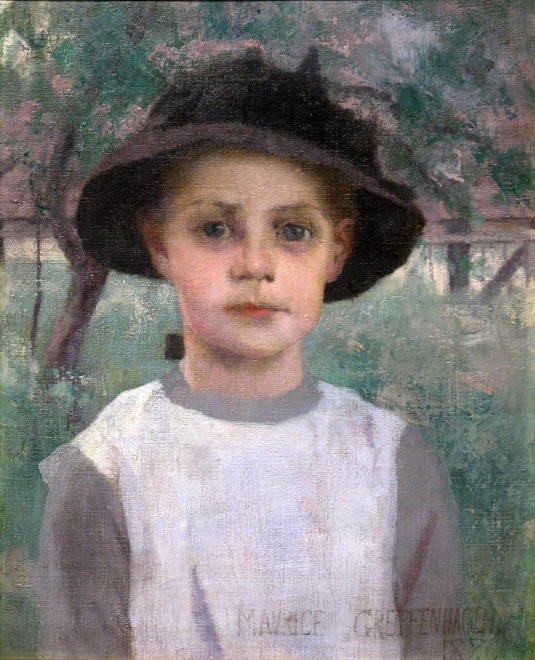Provenance
Bought from the Artist; by descent.
Literature
A child poses in an orchard; she wears a broad-brimmed black hat and a white pinafore over her pale grey-blue tunic; she stares directly at the spectator as if for a photograph; her gaze appears expressionless. A closer look and the orchard is no more than an 'impression'; the rough texture of the trees, foliage and grass is conveyed by paint smoothed into the canvas surface with a palette knife; only the girl's dress and flesh-tones are treated with precision, and with wide eyes, she commands our attention. The artist, Maurice Greiffenhagen, has inscribed his name in block capitals at the lower right edge of the little canvas so delicately that it is almost imperceptible, and under it has added the date, '1886'. The numerals - a '1', two flattened '8s' and a rounded '6' - like the signature, are stated with such sensitivity that they do not draw the eye.
Few paintings could more typify avant-garde practice in Britain in the mid-1880s than this work by a young painter, still fresh from completing his studies at the Royal Academy Schools. In the previous year he had painted a 'Hamlet' composition that amply demonstrated his abilities, although despite its precocity, it failed to gain first prize in the school's gold medal and travelling scholarship competition because it was regarded as too 'Frenchy'. Up to this point, Greiffenhagen had been widely recognized as the Schools' most talented student and ironically was then unable to complete his training in the Paris ateliers.
It was nevertheless an impressive piece of work that echoed the modern Salon paintings of Jean-Paul Laurens, Pascal-Adolphe-Jean Dagnan-Bouveret and Jules Bastien-Lepage. As such it signalled a new orientation in British painting that found expression in 1886 in the formation of the New English Art Club - at which it was exhibited. It was nevertheless praised for its original treatment of a subject that was all too familiar from the days of the Pre-Raphaelites.
At twenty-four, Greiffenhagen was one of the club's youngest exhibitors, and the rediscovery of A Village Girl from this crucial year graphically demonstrates his precocity. It reveals his early allegiance to the work of George Clausen and Henry Herbert La Thangue, the principal proponents in Britain of Bastien-Lepage's rural naturalism. During Greiffenhagen's student years, the French painter had been the most vehemently debated modern artist. His influence was compounded by the large number of British students who were travelling to Paris to join the ateliers. The impecunious Greiffenhagen did not join the throng, but he would certainly have seen the work of the Lepage naturalists filtering into London exhibitions. If, for instance, if we compare Clausen's Head of a Young Girl, 1884 or La Thangue's Study of a Boy in a Black Hat, c. 1886 with the present picture, some remarkable similarities are revealed.
All three pictures are similar in format and in technical terms. They are naturalistic in the sense that they adopt methods that set out deliberately to achieve verisimilitude. They aim to convince the viewer that the picture simulates a real life encounter. Naturalism was a universal creed and those who shared in this belief even adopted a communal way of inscribing their works. Handwritten signatures, for a time, disappeared. As he passed from La Thangue's In the Dauphiné (Private Collection) to Clausen's Shepherdess at that first New English show, Greiffenhagen formed a clear sense of the direction of British painting.
However for the young painter, this brief foray into rural naturalism was not sustained, and he was compelled to accept work as an illustrator. During the following year he moved to Primrose Hill Studios where his neighbour was John William Waterhouse, an artist who at this point was subtly re-interpreting Pre-Raphaelite themes in the manner of the Salon painters he admired. Denholm Armour, another neighbour, recalled the frequent meetings in Waterhouse's studio and that his young friend, an excellent pianist, was 'fond of fun', notwithstanding his poverty. The return to what James Stanley Little described as 'naturalistic idealism' was predictable and within four years Greiffenhagen achieved a succes d'estime with An Idyll, depicting the desperate embrace of star-crossed Virgilian lovers.
Armour also considered Greiffenhagen 'the leading illustrator in London in spite of the fact that he hated the work'. Like many artists of his generation, Greiffenhagen's earliest successes were in the burgeoning field of illustration. In 1889 he basked in the reflected glory of Henry Rider Haggard's She, for which he supplied a suite of drawings and thereafter publishers sought him out.
In some instances illustrations formed the basis of later 'Symbolist' compositions. However, by the mid-nineties his reputation rested primarily on portraiture. In this he adopted the adopted the mannerisms of Spanish seventeenth century Caravaggesque painting, filtered through the work of Whistler. His full-length portrait of Rider Haggard 1897 (Castle Museum, Norfolk) typifies this trend.
Arguably the present picture provided a solid grounding for this later practice. The scrutiny given to this particular child was commendably rigorous. Like his Naturalist mentors, Greiffenhagen sets the girl before us just as he finds her. In the mid-1880s the call for objectivity of a new kind was a powerful one, and with A Village Girl it was deeply embedded in his approach, becoming part of his 'personal way of looking at things' - as B Kendell later observed, 'without any trick or flourish of paint he asserts his quiet superiority of judgement and skill'. Such qualities are abundantly evident in the plein air picture of a village girl whose silent gaze captures ours.
Kenneth McConkey
